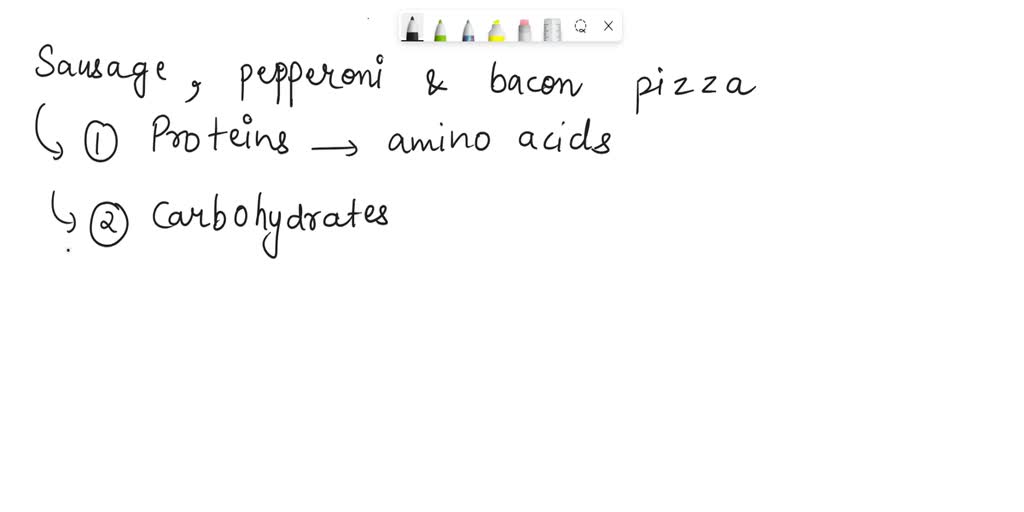Submitted by Jamie D. May. 23, 2022
03:17 p.m.
Pizza is a beloved food for good reason – it tastes amazing! The delicious combination of bread, sauce, cheese and toppings makes pizza a favorite meal or snack for many. But behind the yummy flavors of pizza lie some complex chemistry and biology in the form of macromolecules. Let’s take a closer look at what macromolecules can be found in a pizza loaded up with sausage, pepperoni, and bacon.
An Overview of Macromolecules
Macromolecules are just a fancy name for large molecules that are essential to life. There are four main types of macromolecules that we will find in our loaded pizza:
-
Carbohydrates – These include sugars and starches and are the main source of energy in our diets.
-
Proteins – These are chains of amino acids that do most of the work in our cells and tissues.
-
Lipids – These include fats and oils and are also an important source of energy.
-
Nucleic Acids – These include DNA and RNA and store the genetic information that makes us who we are.
Finding the Carbohydrates
Carbohydrates are going to be the most abundant macromolecule in our pizza, as they are in most foods. The main sources of carbs will be:
-
Bread dough – The dough is made from wheat flour, which is rich in starch. Starch is a complex carbohydrate that gets broken down into glucose during digestion.
-
Tomato sauce – Tomatoes contain the natural sugar fructose as well as some starch.
-
Cheese – Natural cheeses contain a small amount of carbohydrates in the form of lactose, the milk sugar.
So in just the basic pizza ingredients of crust, sauce and cheese, we already have a good dose of carbohydrates. Our added toppings will provide even more.
Adding Proteins with the Meats
Now let’s look at where we’ll get proteins from our loaded pizza:
-
Sausage – Sausage contains a high concentration of protein from the meat (usually pork). Sausage averages about 12-16 grams of protein per ounce.
-
Pepperoni – Pepperoni is another processed meat that provides a good protein punch. A single serving of around 20 small pepperoni slices contains about 8-10 grams of protein.
-
Bacon – Most of the calories in bacon come from fat, but there is still a moderate amount of protein – about 5 grams per slice.
The cheese on the pizza also contributes protein in the form of casein and whey. So our pizza is definitely not lacking for this important macromolecule either.
Finding the Fats in the Meats and Cheese
Now let’s look at the main sources of lipids, or fats, in our loaded pizza:
-
Sausage – In addition to protein, the sausage provides a lot of fat. Pork sausage averages around 15 grams of fat per ounce.
-
Pepperoni – Pepperoni is high in fat, with about 80% of its calories coming from fat. Those 20 small slices will add up to about 10 grams of fat.
-
Bacon – About 75% of bacon’s calories come straight from fat, mostly in the form of saturated fat. Each slice of bacon contains about 5-6 grams of fat.
-
Cheese – Natural cheeses are high in fat, providing a mixture of saturated and unsaturated fats. Whole milk mozzarella provides about 8 grams of fat per ounce.
So in the sausage, pepperoni, bacon and cheese, our pizza gets plenty of lipid macromolecules to supply energy and flavor.
Nucleic Acids Lend Structure and Function
Finally, let’s consider the fourth type of macromolecule – nucleic acids. There will not be high amounts of DNA or RNA in our pizza, but these important molecules will be present in small quantities:
-
Yeast – The yeast used to help the dough rise will contribute some nucleic acids. Yeast are single-celled microorganisms after all, and need DNA and RNA just like other living things.
-
Vegetables – Any veggies on the pizza, like mushrooms, onions or peppers, will also provide traces of DNA and RNA.
-
Meats – The sausage, pepperoni and bacon all came from living cells and tissues, so they will contain tiny remnants of nucleic acids to provide the genetic blueprints.
- Carbohydrates for main energy
- Proteins for structure and function
- Lipids for energy and cell membranes
- Nucleic acids for genetic codes
This complex mix of essential biomolecules is what makes our pizza a nutritious meal in addition to a delicious one!
A Closer Look at Each Macromolecule Group
Now let’s take a more in-depth look at each category of macromolecules found in our loaded pizza:
Carbohydrates
- Mainly found in the wheat-based crust, tomato sauce and mozzarella cheese.
- Provide 4 calories per gram and are broken down into glucose for energy.
- Fibrous carbohydrates in the crust provide structure and texture.
- Main types of carbs are starch and sugars like fructose.
- Estimated total carbs in one slice of a 14-inch pizza is around 60-80 grams.
Proteins
- Concentrated in sausage, pepperoni and bacon meat toppings. Also found in cheese.
- Provide 4 calories per gram and are made of chains of amino acids.
- Essential for building and repairing tissues and creating enzymes.
- Meat proteins like myosin and actin are complete proteins.
- One slice of loaded pizza likely provides 15-20 grams of protein.
Lipids
- Found predominantly in sausage, pepperoni, bacon and cheese.
- Provide 9 calories per gram and consist of fatty acids and glycerol.
- Different types include saturated and unsaturated fats, waxes, phospholipids, etc.
- Support hormone function and provide key flavor compounds.
- Total fat per slice of loaded pizza probably ranges from 15-30 grams.
Nucleic Acids
- Present in very small amounts from ingredients like yeast, vegetables and meats.
- Provide structural support by forming DNA and RNA molecules.
- DNA stores genetic code and RNA helps translate it into proteins.
- Allow for cellular replication and passage of traits between generations.
- Less than 1 gram of nucleic acids per slice of pizza.
The Interaction of the Macromolecules Makes the Pizza Delicious
Pizza is more than just a sum of its parts when it comes to macromolecules. It is the unique interactions between the carbohydrates, proteins, lipids, and nucleic acids that give pizza its beloved taste and texture. Here is how the macromolecules work together:
-
Carbs and Proteins – When wheat flour is mixed with water, the proteins form gluten, which gives the crust its chewy texture. The starches gelatinize and expand into airy bubbles when cooked.
-
Proteins and Lipids – Lipids enhance flavor while proteins maintain structure in the cooked sausage, pepperoni and bacon.
-
Lipids and Carbs – Carbs and lipids combine deliciously in the gooey, elastic melted cheese.
-
Nucleic Acids – DNA guides production of enzymes like amylase which breaks down starches in the mouth while you savor each bite.
So you see, no one macromolecule makes pizza as tasty as it is. It is the synergistic blending of carbs, proteins, fats, and nucleic acids that come together to create a delicious culinary experience. Our bodies recognize and thrive on this balanced nutrition.
Pizza loaded up with meat toppings like sausage, pepperoni and bacon may not be the healthiest meal, but it provides plenty of energy and nutrition from macromolecules. The wheat crust, cheese and tomato sauce contain mostly carbs and proteins, while the meats supply extra protein, fats, and a smattering of nucleic acids. Each macromolecule group contributes something important to make pizza filling and delicious. The complexity of how these large molecules interact during baking and digestion is fascinating biology and chemistry. So next time you grab a slice of loaded pizza, appreciate it as more than just a tasty treat – it’s a veritable laboratory of macromolecules!

Want better grades, but can’t afford to pay for Numerade?
Enter your parent or guardian’s email address:
Already have an account? Log in
Video Answers to Similar Questions Best Matched Videos Solved By Our Expert Educators
Recipe: Easy Sausage Pizza
FAQ
What macromolecule is bacon?
|
31. starch
|
almond
|
celery
|
|
34. protein
|
bacon
|
egg white
|
|
35. starch
|
noodles
|
table sugar
|
|
36. glucose
|
orange juice
|
popcorn
|
|
37. protein/saturated fat
|
cheese
|
lobster
|
What type of macromolecule is pizza crust?
What organic molecules are in pizza?
Does pizza contain nucleic acids?





